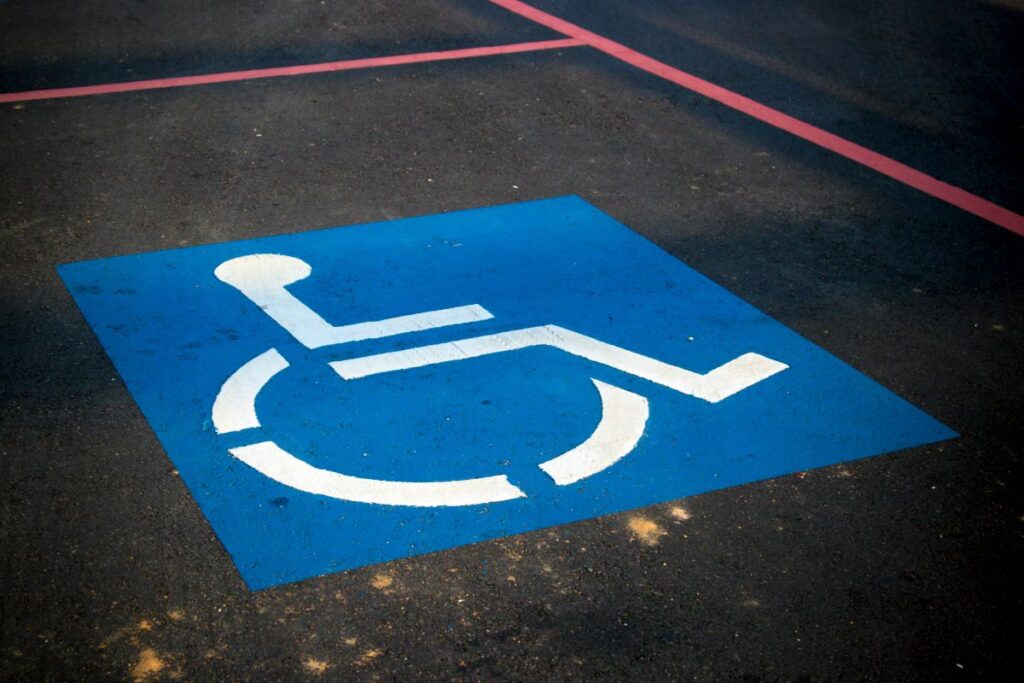The Arizona handicap parking permit application process involves specific eligibility criteria, required documentation, and various application methods to accommodate different applicant needs. The state’s handicap parking permits permit holders to use designated parking spaces closer to entrances, making daily activities more manageable. These permits are essential for individuals with disabilities as they provide convenient access to public facilities, businesses, and services. It’s a way to reduce and manage physical barriers, promote independence, and improve the quality of life for permit holders by eliminating the need to traverse long distances from regular parking spaces.
In this article, we provide a comprehensive guide on how to apply for a handicapped parking permit in Arizona, outlining eligibility criteria, required documentation, the application process, fees, renewal procedures, special circumstances, and available resources.
Understanding Handicap Parking Permits
The Purpose of a Handicap Parking Permit in Arizona
The purpose of a handicap parking permit in Arizona is to provide individuals with disabilities easier access to public and private facilities by allowing them to park in designated handicap spaces, which are typically located closer to entrances and have more space for vehicle accessibility needs. This helps ensure that those with mobility impairments or other qualifying conditions can navigate their environments more conveniently and safely.
Qualifying Disabilities for a Handicap Permit in Arizona
To qualify for a handicapped parking permit in Arizona, individuals must have a disability that severely impairs their mobility. This includes conditions such as the inability to walk 200 feet without stopping to rest, the need for a mobility device, or specific medical conditions that necessitate proximity parking.
Here are some of the qualifying disabilities an individual must meet in Arizona to receive a permit. Remember to always check with your professional healthcare provider to discuss your options further:
- Limited Mobility: Individuals who cannot walk 200 feet without stopping to rest.
- Lung Disease: Individuals with a forced expiratory volume (FEV) for one second, when measured by spirometry, of less than one liter, or arterial oxygen tension (PO2) less than 60 mm/hg on room air at rest.
- Heart Condition: Individuals with a cardiac condition classified as Class III or IV by the American Heart Association.
- Portable Oxygen: Individuals who require the use of portable oxygen.
- Arthritis, Neurological, or Orthopedic Condition: Individuals with a condition that severely limits their ability to walk.
- Use of Assistive Devices: Individuals who require the use of a brace, cane, crutch, another person, prosthetic device, wheelchair, or other assistive devices.
- Severe Visual Impairment: Individuals with a visual impairment that severely limits their ability to walk.
Types of Permits Available in Arizona
Arizona issues both temporary and permanent handicap parking permits. Temporary permits are valid for up to six months, while permanent permits are issued for longer durations based on the nature of the disability.
Here are further details about each available handicapped parking permit in Arizona:
- Temporary Placards:
- Issued to individuals with a temporary disability.
- Valid for up to six months.
- Can be renewed if the temporary disability persists.
- Permanent Placards:
- Issued to individuals with permanent disabilities.
- Valid for five years.
- Must be renewed every five years, though the renewal process is generally straightforward.
- Permanent Disability License Plates:
- Issued to individuals with permanent disabilities who own a vehicle.
- Valid as long as the vehicle registration is active.
- Allows the vehicle to be parked in designated handicap spaces.
- Travel Placards:
- Issued to Arizona residents with permanent disabilities who travel out of state.
- Valid for up to 30 days.
- Intended to be used temporarily when the person is traveling and needs handicapped parking privileges in other states.
- Organizational Placards:
- Issued to organizations that transport individuals with disabilities.
- Valid for five years.
- Allows the organization’s vehicles to park in handicapped spaces while transporting eligible individuals.
Required Documentation
Applicants must provide medical certification from a licensed healthcare provider verifying their disability. The certification should include details about the nature and extent of the disability that justifies the need for a handicapped parking permit. Alongside medical certification, applicants must submit identification documents, such as a valid Arizona driver’s license or state ID card to confirm residency and identity.
Arizona offers two types of handicap parking permits: placards that are hung from the rearview mirror and license plates that are affixed to vehicles. Applicants can choose either option based on their preference and mobility needs.
Here are more details about the required documentation and responsibilities of the applicant:
- Completed Application Form: The applicant must fill out the Disability-Hearing Impaired Plate/Placard Application (Form 96-0104).
- Medical Certification: A licensed healthcare provider (such as a physician, registered nurse practitioner, or other qualified professional) must complete the medical certification section of the application form. This section requires the healthcare provider to:
- Specify the nature of the disability.
- Confirm that the disability meets the qualifying conditions for a handicapped parking permit.
- Indicate whether the disability is temporary or permanent.
- Provide their professional license number and contact information.
- Proof of Identity: The applicant must provide proof of identity, such as a valid Arizona driver’s license or identification card.
- Vehicle Information (if applying for license plates): If the applicant is applying for a disability license plate, they must provide vehicle information, including the make, model, year, and vehicle identification number (VIN).
- Fees: While placards are typically issued at no cost, there may be fees associated with the issuance of disability license plates.

Application Process
The steps to apply for a handicapped parking permit in Arizona include the following:
- Obtain the Application Form: The Disability-Hearing Impaired Plate/Placard Application (Form 96-0104) can be downloaded from the Arizona Department of Transportation (ADOT) website or picked up at an MVD office.
- Complete the Form: The applicant fills out their personal information and vehicle details (if applicable).
- Medical Certification: The healthcare provider completes and signs the medical certification section of the form.
- Submit the Application: The completed application can be submitted by mail or in person at an ADOT MVD office or an authorized third-party provider.
Online Application
Arizona also offers an online application option through the MVD website, providing convenience for applicants who prefer to complete the process electronically. This method typically requires uploading scanned copies of required documents.
You can also easily use our Dr. Handicap online platform to apply for your handicap placard today. We serve as an intermediary between handicapped drivers and the state’s DMV during the application process. You won’t need to wait in lines and you can complete the process from the convenience of your home.
Fees and Renewal Process
Fee structure
Arizona charges a nominal fee for both the initial issuance and renewal of handicapped parking permits. Fees may vary depending on whether the applicant opts for a placard or a license plate.
Renewal requirements
Handicap parking permits in Arizona require periodic renewal. Permanent permits typically need to be renewed every five years, whereas temporary permits have a shorter renewal period. Renewal involves verifying continued eligibility and may require updated medical documentation.
Special Circumstances
Replacing lost or stolen permits
In the event of a lost, stolen, or damaged permit, Arizona allows for replacement upon submission of a written request. The replacement process ensures that permit holders can continue to benefit from accessible parking.
You can learn more by reading our post, ‘How Do I Replace a Lost or Stolen Handicap Parking Permit’.
Temporary permits for visitors
Visitors to Arizona who require handicapped parking privileges can obtain a temporary permit valid for the duration of their stay. These permits require documentation similar to those for residents but are issued with a shorter validity period. You can also learn more about handicap permit reciprocity in our blog.
Resources and Assistance
Contact information for relevant agencies
For detailed information and assistance regarding the Arizona handicap parking permit application process, applicants can contact the Arizona Department of Transportation (ADOT) or visit their local MVD office. Contact details and office locations are readily available on the ADOT website.
Organizations offering assistance with applications
Various disability advocacy organizations and support groups in Arizona offer valuable assistance to individuals applying for handicapped parking permits. These organizations provide guidance, support, and resources to help applicants navigate the application process smoothly. Here are some notable organizations and the types of assistance they offer:
1. Disability Rights Arizona
- Services Provided:
- Legal advice and representation for individuals with disabilities.
- Assistance with understanding eligibility requirements and completing application forms.
- Guidance on appealing denied applications.
2. Ability360
- Services Provided:
- Information and referral services for individuals with disabilities.
- Assistance with filling out handicap parking permit applications.
- Workshops and training sessions on navigating disability-related services and benefits.
3. United Cerebral Palsy of Central Arizona (UCP)
- Services Provided:
- Support and resources for individuals with cerebral palsy and other disabilities.
- Help with completing handicap parking permit applications.
- Assistance with accessing various disability-related services and benefits.
4. The Arc of Arizona
- Services Provided:
- Advocacy and support for individuals with intellectual and developmental disabilities.
- Assistance with the application process for handicapped parking permits.
- Resources and information on disability rights and services.
5. Local Independent Living Centers (ILCs)
- Services Provided:
- Various ILCs across Arizona provide support and advocacy for individuals with disabilities.
- Resources and referrals for additional services and benefits.
These organizations can provide crucial support, ensuring that individuals with disabilities receive the assistance they need to successfully apply for and obtain handicapped parking permits.
Evaluation and Approval
The evaluation and approval process for a handicapped parking permit in Arizona is designed to ensure that permits are granted to individuals with genuine needs. After completing the application process, the ADOT MVD reviews the application to verify completeness and accuracy. If additional information is needed, the applicant may be contacted. Upon approval, the applicant is issued a temporary or permanent placard or license plate, depending on the nature of the disability. This process ensures that only those with legitimate disabilities receive the benefits of designated handicap parking, promoting accessibility and convenience for Arizona’s disabled community.
Using the Handicap Parking Permit
Using a handicapped parking permit correctly is essential to avoid legal consequences and ensure that these designated spaces are available for those who truly need them. Here are some key tips to help you use your permit appropriately and within the legal guidelines:
- Always display the permit: Ensure the placard is clearly visible, hanging from the rearview mirror when the vehicle is parked in a handicap space. If using a license plate, it should be properly affixed to the vehicle.
- Use the permit only when necessary: The permit is intended for use only when the person with the disability is either driving or being transported in the vehicle. Do not use the permit when the disabled individual is not present.
- Avoid misuse: Do not lend your permit to others or use someone else’s permit. Misuse can result in fines, revocation of the permit, and other legal consequences.
- Renew on time: Keep track of the expiration date and renew your permit as needed. Temporary permits need renewal after six months, while permanent permits must be renewed every five years.
- Park in designated spaces only: Use your permit only in designated handicapped parking spaces. Do not park in spaces marked for specific uses, such as loading zones or fire lanes.
By following these guidelines, you can ensure proper use of your handicapped parking permit and avoid any legal issues.
Handicap Parking Permit in Arizona Explained
We hope you have a better understanding of the Arizona handicap parking permit application process. It involves understanding eligibility criteria, gathering the necessary documentation, choosing an application method, paying applicable fees, and adhering to renewal requirements. By following these steps, individuals with disabilities can gain access to accessible parking spaces that enhance their daily mobility and independence.
In conclusion, obtaining a handicapped parking permit in Arizona is a structured process designed to prioritize accessibility and convenience for individuals with disabilities. By familiarizing themselves with the outlined steps and utilizing available resources, applicants can successfully navigate the application process and enjoy the benefits of accessible parking accommodations throughout the state.
Featured image by Philippe Serrand on Pexels.



